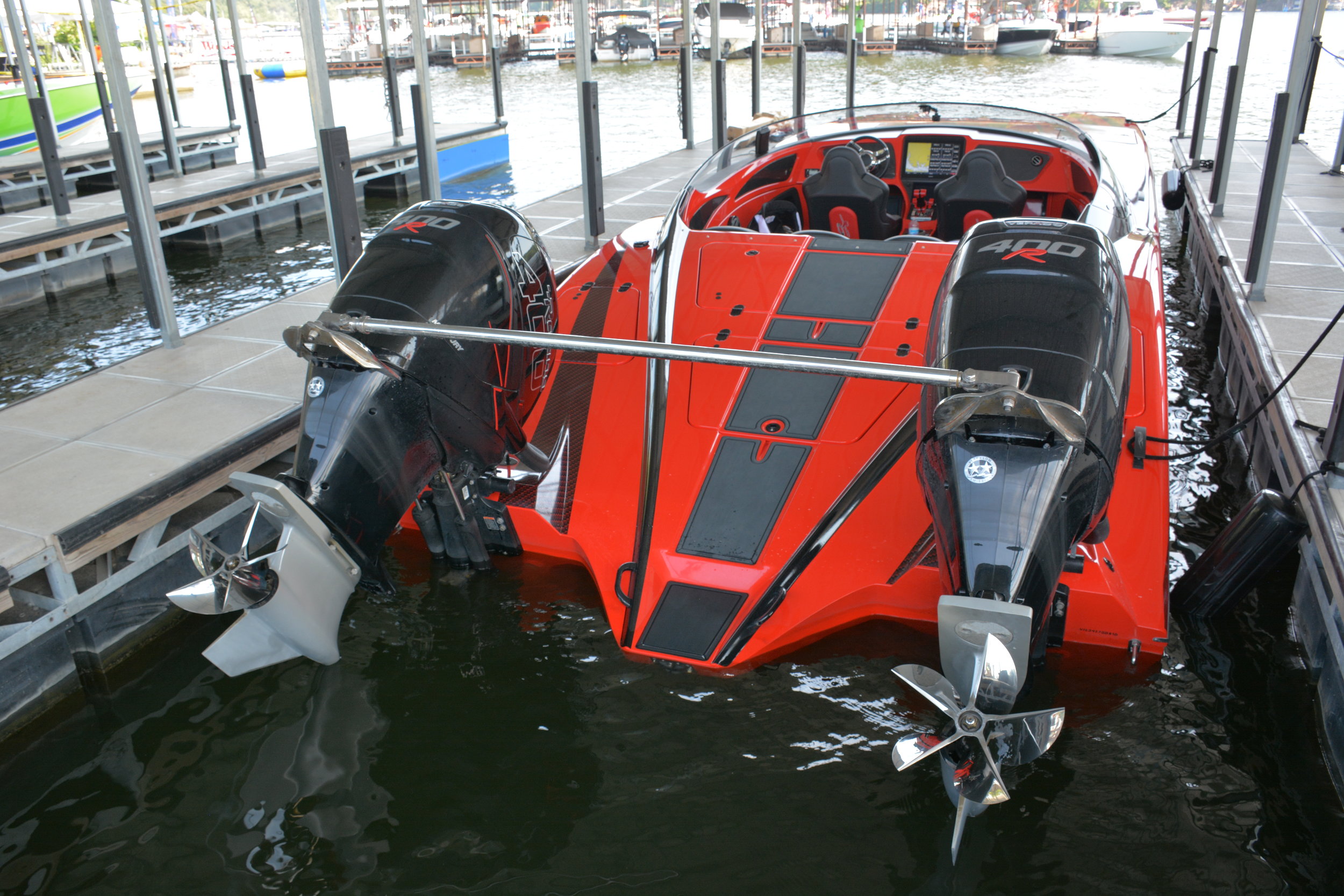Mercury Racing Verado 400R: The First True High Performance Four Stroke Outboard will be Gone Soon
Back in 2004, the biggest outboard engine manufacturers at the time, Mercury, Yamaha, and Evinrude, were humming along with their two stroke platforms. Direct injection two strokes were the latest technology for the venerable engine design. Outboards were light, powerful, getting more efficient and more reliable than ever. For a few reasons, the king of performance two strokes, Mercury Marine, had been working diligently on a completely new platform. Not just any new engine, it was a project that attempted to question everything we thought we knew about outboards. A diverse set of engineers, and a whole new philosophy gave birth to the Mercury Verado series. Considering four stroke outboards were laughed at on the water back then, reserved for low HP boats, this was a massive shift change. Today, the latest, and most likely last iteration of the original Verado, the 400R, is the final showpiece for the platform born fifteen years ago.
Key innovations of the Verado program were the electro hydraulic integrated steering, redesigned bracket, digital controls, and most obviously; the 2.6 liter four stroke power plant. One key team member, Claus Brestle, who previously held an R&D position at Porsche AG, was rumoured to be instrumental in the steering implementation. Although a good system in general, the sloppy mounts and mushy steering feel was not good for performance use, but was good for slower big boats that are less concerned with precise steering feel. Obviously, at almost 700 pounds, high performance wasn’t top of mind.
Verado
Early Verado's had 4.88" gearcases, later updated to the beefy 5.44 HD gearcase with 1.75 or 1.85 gear ratios.
What was really surprising was the idea of using a small displacement forced induction engine design. In a way, this was way ahead of the times for marine, and no doubt influenced by the automotive industry. The Verado philosophy itself at least had a few ideas borrowed from the automotive world. Today, it is very common to use small forced induction engines in cars and trucks, even luxury cars, but that was just starting in the early 2000s. Of course, in the marine environment, there are many drawbacks to using forced induction in an outboard, where heat, weight and complexity are issues.
Mercury Racing modified the Verado 2.6 liter engine to rev up to 7,000 RPM and produce an impressive turnkey 400 HP.
Although steering in outboards had changed quite a bit before the Verado, in the form of front mounted hydraulic rams, it was uncommon to have integrated steering. Front mounts are a direct descendent and improvement over cable steering; early ones were mediocre, now they are very precise and durable. But what we see now in the latest outboards is completely integrated steering, built right into the steering bracket itself in either a vertical helix gear like the Evinrude G2; which has an additional electric assist motor. The new Yamaha 425 has a completely redesigned bracket with an electric steering system designed with two drivers in a Y shape, making the steering completely part of the midsection.
These new steering systems have many advantages, not the least of which is the simple rigging, no third party compatibility issues and are technically more safe, featuring built in fail safes. Count on Yamaha having this technology trickle down to their smaller engines soon, and Evinrude already has utilized it in their mid range engines. This type of steering is the future, no doubt about it, and the Verado started that line of thinking.
Notice the steering, clean rigging and integrated unit are an improvement over remote rams. Not quite as slick as the latest integrated systems from Evinrude or Yamaha, but nice.
Digital is how all new outboards are going to be. Fly by wire, digital controls and electric actuators replace any mechanical components. With a plug in wiring harness, and a hydraulic line, it is way more simple and truly plug and play. Other features are improved diagnostics, as well as more refined functions, no clunking, no grinding and another new thing; automation. All of the new engines can be “automated” or controlled by a computer. This makes the idea of joystick controls, virtual anchoring features, and self docking possible. Digital engines can not only be controlled by computers, but they can communicate information back to those computers. It seems scary, but pressing a button and having the boat dock itself is far less scary than having your drunk brother in-law take the wheel and put a $5,000 gouge in the side of your boat, all while spilling his warm beer all over the place. I’ll take the computer over the brother in-law all day.
The initial Verados were definitely innovative, but they do have a few drawbacks. They were so heavy, it made them only really useful on heavier beamier hulls, despite initially being touted with performance potential, they were dogs. Verado motor mounts were soft rubber, making the steering feel like you were driving a school bus, which is one of the costs of having a silent, vibration free ride. To give an idea of the weight, the new 300 V8 Verado is about 100 pounds lighter. An Evinrude G2 300 is about 150 Lbs lighter. Back in 2005, a 250 Verado was just not on par with the 250 Mercury DFI two stroke variants at the time. Not only that, they just weren’t as fuel efficient or emission friendly.
The Verado 400R is right at home on the back of big center consoles with the HD gearcase and multiple engine installations, like this quintuple setup. Ya, that's 5.
Many of the features mentioned added to the weight, but not only was it massive, the tall inline 6 cylinder design made it very top heavy, again, not suitable for most performance boats. It wasn’t until Mercury Racing got a hold of it that it improved on some of these shortcomings. The first Mercury Racing version, the 350 Verado was at least one of the most powerful outboards on the market. But, it couldn’t hold a candle to a 300X or 300XS of that era. It really wasn’t until the Mercury Racing 400R version that it was a full out Mercury Racing product, and a true performance outboard.
The twin 400R setup in the sport cat segment seems to be the perfect match, owing to the proliferation of cat outboards in the 28' to 36' range. Great performance and reliablility.
The 400R is the ultimate outboard for big center consoles, sport cats, and the odd single engine hull that can handle it. The big engine opened up a totally new market for Mercury Racing, one with big margins and virtually no competition. You simply can’t get an engine with solid mounts, optional gearcases, and a warranty with that much power other than the 400R. The new 300R is the next closest thing, if you’re talking about hardcore performance outboards, and is so far showing to be peerless in its performance as well. In fact, Mercury Racing is unique in that they have basically no competition. But, this is the last version of the forced induction 2.6 liter Verado engine. Mercury Marine’s new direction of large displacement will be the design philosophy going forward. The new V8s are loafing at 300 HP, and are way lighter and more efficient than the big Verado. It isn’t a matter of if they will replace the 400R, it’s when, and its replacement will definitely sound better, that is assured.
When shopping for propellers for the 400R, don't forget your wallet.












